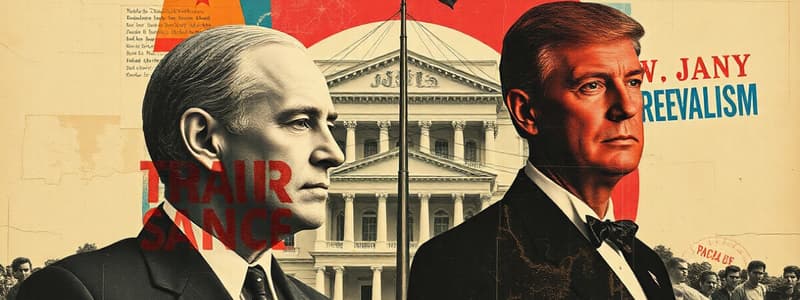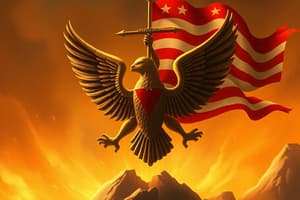Podcast
Questions and Answers
The executive branch's power to appoint Supreme Court justices is checked by the need for approval from which body?
The executive branch's power to appoint Supreme Court justices is checked by the need for approval from which body?
- The Judicial Branch
- The Electoral College
- The Senate (correct)
- The House of Representatives
Which of the following best describes the function of the Preamble to the Constitution?
Which of the following best describes the function of the Preamble to the Constitution?
- It establishes the three branches of government.
- It states the goals and purposes of the government.
- It lists the individual rights of citizens.
- It outlines specific laws and regulations. (correct)
Montesquieu's idea of dividing government into different branches directly influenced which key principle in the U.S. Constitution?
Montesquieu's idea of dividing government into different branches directly influenced which key principle in the U.S. Constitution?
- Judicial Review
- Federalism
- Separation of Powers (correct)
- Checks and Balances
The Eighth Amendment directly prohibits which of the following?
The Eighth Amendment directly prohibits which of the following?
How does the judicial branch check the power of the legislative branch?
How does the judicial branch check the power of the legislative branch?
Which principle established in the Magna Carta influenced the U.S. Constitution?
Which principle established in the Magna Carta influenced the U.S. Constitution?
The landmark Supreme Court case Marbury v. Madison (1803) established what key principle?
The landmark Supreme Court case Marbury v. Madison (1803) established what key principle?
The Fourth Amendment protects individuals from which of the following government actions?
The Fourth Amendment protects individuals from which of the following government actions?
Which of the following best describes the principle of federalism?
Which of the following best describes the principle of federalism?
Which early American document, adopted in 1777, represented the first attempt at a national government but was later replaced?
Which early American document, adopted in 1777, represented the first attempt at a national government but was later replaced?
Flashcards
What is the Senate?
What is the Senate?
The body that must approve Supreme Court justices appointed by the executive branch.
What is the Preamble?
What is the Preamble?
Outlines the goals of the government and begins with 'We the People'.
What is separation of powers?
What is separation of powers?
Dividing government into separate branches.
What are cruel and unusual punishments?
What are cruel and unusual punishments?
Signup and view all the flashcards
What is the constitution?
What is the constitution?
Signup and view all the flashcards
What is the Magna Carta?
What is the Magna Carta?
Signup and view all the flashcards
What is Marbury vs Madison?
What is Marbury vs Madison?
Signup and view all the flashcards
What is the Fourth Amendment?
What is the Fourth Amendment?
Signup and view all the flashcards
What is federalism?
What is federalism?
Signup and view all the flashcards
What is the tenth amendment?
What is the tenth amendment?
Signup and view all the flashcards
Study Notes
- The Senate approves Supreme Court Justice appointments made by the executive branch.
- The Preamble outlines the goals of the government and starts with "We the People."
- Montesquieu's concept of dividing government inspired the separation of powers principle in the U.S. Constitution.
- The Eighth Amendment prohibits excessive bail, fines, and cruel and unusual punishments.
- The judicial branch checks the legislative branch by ensuring laws align with the Constitution.
- The Magna Carta, signed in 1215, limited the English monarchy's power and introduced due process.
- Marbury v. Madison (1803) established the Supreme Court's power of judicial review.
- The Fourth Amendment protects against unreasonable searches and seizures without a warrant.
- Federalism divides power between national and state governments.
- The Articles of Confederation, adopted in 1777, was the first attempt at a national government but was replaced due to its weaknesses.
- The Constitution was ratified after promising to add the Bill of Rights to protect individual rights.
- The Great Compromise created a bicameral legislature, balancing representation for large and small states.
- The Tenth Amendment reserves powers not given to the federal government to the states or the people.
- The legislative branch can override a presidential veto.
- The Enlightenment, emphasizing reason, individual rights, and self-government, influenced the Founding Fathers.
- Impeachment and conviction is a constitutional mechanism allowing Congress to remove a sitting president, requiring a majority vote in the House and a 2/3 vote in the Senate.
Studying That Suits You
Use AI to generate personalized quizzes and flashcards to suit your learning preferences.




